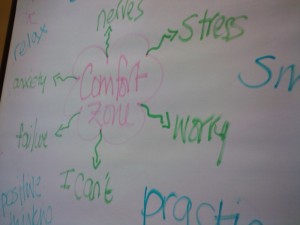How to cope when your speaking time’s been cut short
The previous speakers over-ran, and little by little your time’s been chipped away …
From forty-five minutes you’ve now got thirty, twenty, ten …
You could just insist, doggedly sticking to your prepared script, getting all your anecdotes, examples and details out there, oblivious to the sullen expressions, theatrical watch-glancing and ‘I’m going to be late … ‘ phone calls.
You could reschedule – chances are people came because they wanted to hear what you have to say.
Or you could save the day and gracefully and elegantly deliver a stripped-down presentation on time, with all key messages and your reputation intact. Clarity, simplicity and brevity are public speaking virtues. No-one ever complained about a short, snappy, memorable talk.
It probably won’t happen. But be prepared in advance, so if it does, you can keep your cool.
Here’s how:
Ask yourself ‘What does this group of people need to hear from me right now?’
Remember your aim – your clear one-sentence statement that says exactly what you’re aiming to achieve. And if you can’t Tweet it you probably haven’t got it yet, so now’s the time to hone it down.
Remember your objectives – what do you want them to know, to be able to do, to take away from the experience? Keep it to three maximum, to help retention.
Identify the core essentials, the key points and messages you want to deliver, then arrange your material into must-have, should-have and nice-to-have levels.
Use coloured Post-Its while preparing, to clearly identify those levels, and what you could drop while remaining on-message.
You might like to print your notes on different coloured note-cards, to help you make snap decisions if you have to cut mid-speech.
It takes confidence to ditch, but the nice-to-haves and the should-haves can go because they’re extras. Whatever happens, your key must-haves remain.
You can still ensure they receive the extras, via your handouts, uploading your presentation, pointing them to articles on your website, offering a chat over coffee – you might gather a crowd and some new contacts.
Always leave them wanting more – not less.


